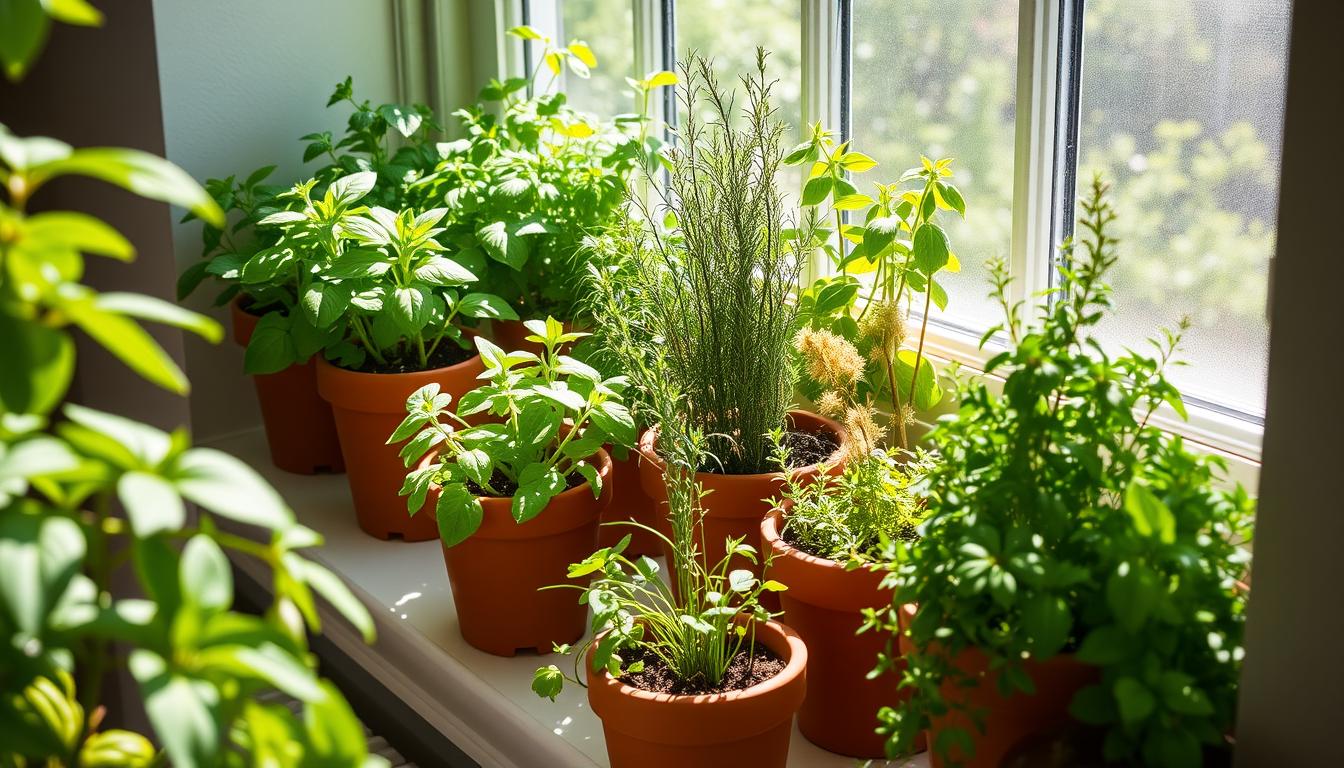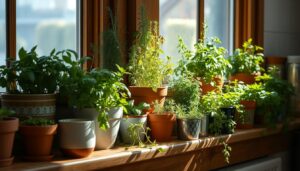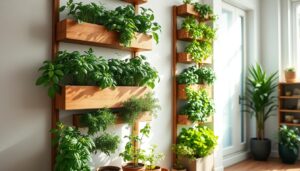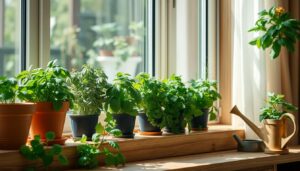Ever thought about filling your kitchen with fresh herbs all year? Starting an indoor herb garden from seeds lets you do just that. This guide will show you how to grow a lush, fragrant garden indoors.
It doesn’t matter if you’re new to gardening or have years of experience. This guide will help you pick the right herbs, prepare the seeds, and keep your garden healthy. You’ll learn how to harvest your own herbs and enjoy cooking with them all year.
What is an Indoor Herb Garden?
An indoor herb garden lets you grow fresh, fragrant herbs at home. It’s different from outdoor gardens. You can enjoy homegrown herbs all year, even when it’s cold outside.
These gardens fit on windowsills, countertops, or under grow lights. They make it easy to get indoor herb garden ingredients. By growing herbs indoors, you can add fresh flavors and smells to your cooking and baking.
Anyone can start an indoor herb garden. It’s a great way to container garden herbs. You’ll love having homegrown herbs right at your fingertips.
| Herb | Ideal Conditions | Common Uses |
|---|---|---|
| Basil | Bright, sunny locations | Pesto, tomato dishes, Italian cuisine |
| Mint | Partial shade, well-draining soil | Teas, mojitos, garnishes |
| Rosemary | Full sun, dry soil | Roasted meats, potatoes, Mediterranean dishes |
“Growing your own herbs at home is a game-changer. The freshness and flavor are unbeatable, and it’s so satisfying to be able to snip a few leaves whenever you need them.”
Benefits of Growing Herbs Indoors
Growing an indoor herb garden brings many benefits. You’ll always have fresh, flavorful herbs for your cooking. These herbs taste better than what you can buy in stores.
Also, an indoor herb garden lets you enjoy homegrown herbs year-round. This is great during cold months when you can’t garden outside. You’ll always have the herbs you need to make your dishes taste better.
Fresh and Flavorful Ingredients
One big plus of growing herbs indoors is getting fresh, flavorful ingredients easily. Herbs from your home are more potent and aromatic than store-bought ones. They’re harvested at their best and ready for your cooking right away.
Year-Round Supply
Having an indoor herb garden means you can enjoy your favorite herbs all year. Outdoor gardens have seasons, but indoor gardens don’t. So, you can grow herbs and use them in your cooking anytime, no matter the weather.
This means you can always add homegrown herbs to your meals. They bring depth and flavor to your cooking. With an indoor herb garden, you’ll never run out of your favorite fresh herbs.
Choosing the Right Herbs
Starting an indoor herb garden means picking the right herbs for a great harvest. It’s important to choose herbs that are easy to care for and fit your cooking style.
Easy-to-Grow Indoor Herbs
Some of the easiest herbs to grow indoors are:
- Basil
- Mint
- Chives
- Parsley
- Thyme
These herbs are tough and can do well in indoor spaces with limited light. They need little care and give you fresh, tasty herbs for your meals.
Herbs Based on Your Culinary Preferences
It’s also key to pick herbs that fit your cooking style. Think about the herbs you use most in your recipes, like herbs for cooking. This way, you’ll always have the ingredients you need.
| Herb | Culinary Uses |
|---|---|
| Basil | Pesto, tomato dishes, Italian cuisine |
| Rosemary | Roasted meats, potatoes, Mediterranean dishes |
| Cilantro | Mexican and Asian cuisines, salsas, curries |
| Thyme | Soups, stews, roasted vegetables, poultry dishes |
By thinking about both how easy they are to grow and your cooking needs, you can make an indoor herb garden that does well and gives you the best herbs to grow indoors for your recipes.
Supplies Needed
Starting an indoor herb garden needs a few key items. First, decide if you’ll use seeds or seedlings. Seeds are cheaper but take longer to grow. Seedlings are quicker but cost more.
You’ll also need containers and a good potting mix. Choose small pots or window boxes that fit your space and herbs. A potting mix made for containers will help your herbs grow well.
Seeds or Seedlings
For your indoor herb garden, you can pick between growing herbs from seed or using herb garden containers with seedlings. Each method has its benefits:
- Seeds save money but need more time and effort.
- Seedlings start faster but are pricier.
Containers and Potting Mix
After choosing your herb source, pick the right herb garden containers and potting mix. Find containers that match your space and herbs. Use a potting mix made for containers that drains well.
| Supplies | Description |
|---|---|
| Seeds or Seedlings | Choose between cost-effective seeds or convenient seedlings to start your indoor herb garden. |
| Containers | Select small pots, window boxes, or other containers that fit your space and herbs. |
| Potting Mix | Use a high-quality, well-draining potting mix designed for container gardens. |
With the right supplies for indoor herb garden, you’re set to grow a beautiful indoor herb garden. You can start with growing herbs from seed or use herb garden containers with seedlings.
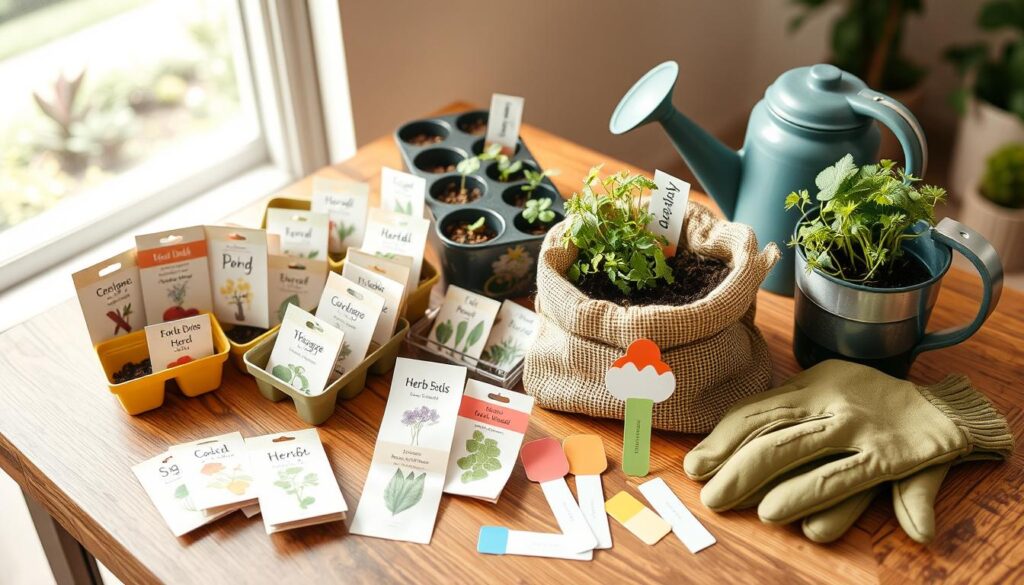
Preparing the Seeds
Starting your indoor herb garden? First, prepare your seeds for planting. Whether you’re starting from seed or using seed starting techniques, getting it right is key. This ensures a thriving, bountiful harvest.
Seed Starting Techniques: Unlocking the Potential of Your Herbs
Starting herbs from seed requires knowing their light needs. Some, like basil, love bright light, while others, like parsley, need darkness during germination. Using the right techniques, like seed trays or jiffy pods, helps your seeds sprout and grow strong.
By using these seed starting techniques, you can give your indoor herbs a great start. This sets the stage for a lush, full indoor herb garden. Dive in and discover how to grow your own fresh, flavorful herbs at home.
“With the right preparation and seed starting techniques, you can transform your indoor space into a thriving herb oasis.”
- Assess the light needs of your herb seeds: Some prefer bright, direct light, while others thrive in partial shade.
- Utilize seed trays or jiffy pods to ensure optimal germination and root development.
- Follow the specific sowing instructions for each herb variety, taking into account depth, spacing, and soil requirements.
- Provide the right growing conditions, such as consistent moisture and warmth, to support healthy seedling growth.
Indoor Herb Garden
Starting an indoor herb garden is fun and rewarding. Think about the layout and design to make it look good and work well. Setting up an indoor herb garden means arranging your containers to get lots of light and use space well.
When planning your indoor herb garden layout, think about how big each herb will get. Put taller herbs like rosemary or thyme at the back. Shorter herbs like basil or oregano go in the front. This way, all plants get enough sunlight and don’t block each other.
For the herb garden indoor design, consider a tiered setup. Use shelving, plant stands, or old furniture. This makes your garden look better and lets you grow more herbs in a small space.
Put your indoor herb garden near a sunny window or under grow lights. With creativity and care, you can make a beautiful indoor herb garden. It will give you fresh, tasty herbs all year.
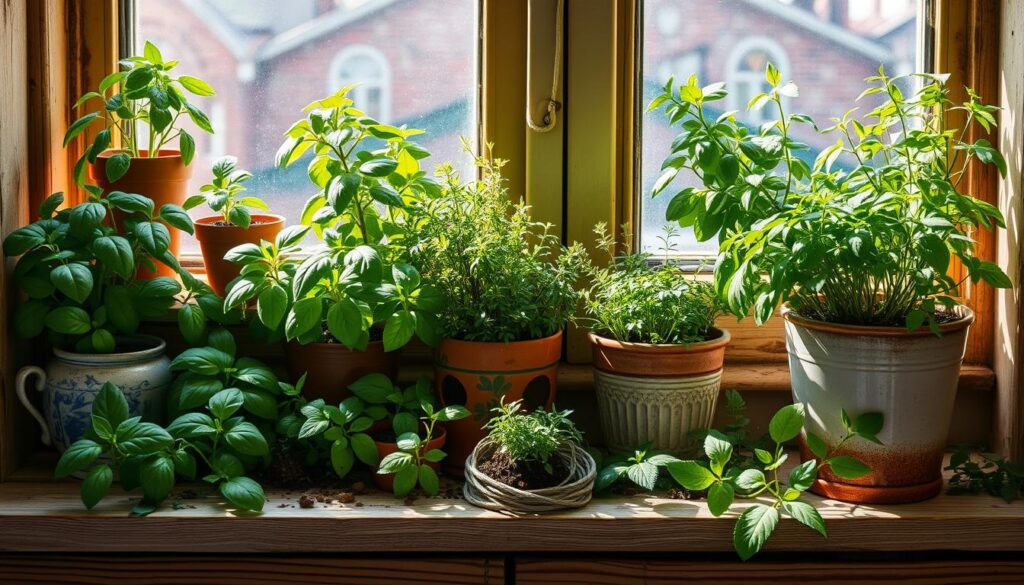
Optimal Growing Conditions
Getting the right growing conditions is key for your indoor herb garden’s success. Herbs do best in certain lighting, temperature, and humidity levels. By keeping these conditions right, you can make a lush indoor space for your favorite herbs.
Lighting Requirements
Herbs need a lot of sunlight, about 4-6 hours a day. Place your indoor herb garden near a south- or west-facing window for the best indoor herb garden lighting. If you don’t get enough natural light, consider using a grow light to help your herbs grow.
Temperature and Humidity
The ideal temperature for indoor herbs is between 65-75°F. This temperature is close to what herbs naturally prefer. Also, the right humidity for indoor herb garden is important. Herbs do well in humidity levels of 40-60%. You can use a humidifier or mist your plants to keep the humidity right.
“Proper lighting, temperature, and humidity are the three pillars of a thriving indoor herb garden. Get these elements right, and you’ll be rewarded with a bountiful harvest of fresh, flavorful herbs year-round.”
Give your indoor herbs the right light, temperature, and humidity. This will help them grow well and taste great.
Watering and Fertilizing
Keeping your indoor herb garden moist and full of nutrients is key to their health and growth. Proper watering indoor herb garden practices help your herbs flourish all year. Make sure the soil stays moist but don’t let it get too wet or dry.
Along with watering indoor herbs, using a mild, balanced fertilizing indoor herbs plan is important. Choose organic or slow-release fertilizers with a mix of nutrients. Follow the instructions for how much and how often to apply for best herb garden care.
| Herb Type | Watering Frequency | Fertilizer Recommendation |
|---|---|---|
| Basil | Keep soil moist, water when top inch is dry | Apply a balanced, water-soluble fertilizer every 2-3 weeks |
| Thyme | Allow soil to partially dry out between waterings | Use a slow-release organic fertilizer every 4-6 weeks |
| Mint | Keep soil consistently moist | Apply a balanced, liquid fertilizer every 4 weeks |
By keeping an eye on your indoor herb garden’s watering and fertilizing, your herbs will stay healthy, bright, and ready to use all year.
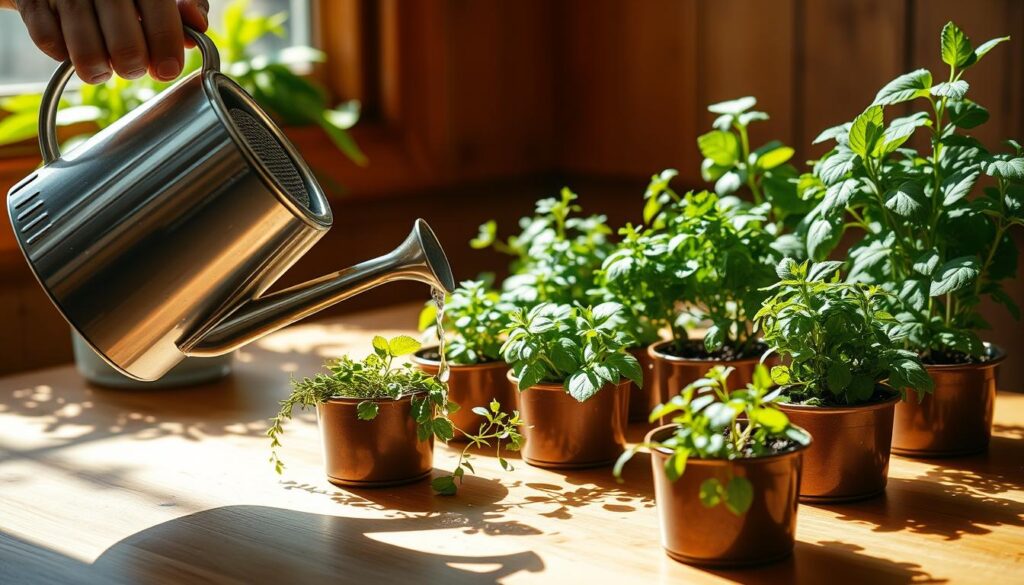
“Proper watering and fertilizing are the keys to a thriving indoor herb garden. With the right care, you can enjoy a bountiful harvest of fresh, flavorful herbs all year long.”
Pest and Disease Management
Keeping an indoor herb garden healthy means watching out for pests and diseases. Common pests like aphids, spider mites, and fungus gnats can harm your plants quickly. But, you can fight back and keep your garden safe and full of life.
Preventive Measures
Preventing pests and diseases is key. Check any new plants before adding them to your garden. This helps stop infestations early. Make sure your plants have good air flow and don’t overwater them. These steps help prevent pests and diseases.
Also, think about using natural ways to keep pests away. This could mean adding good insects or using essential oils. By being proactive, you can keep your indoor herbs healthy and ready for your cooking.
The key to a successful indoor herb garden is keeping a close eye on your plants and taking prompt action at the first sign of trouble.
Harvesting and Pruning
Regularly harvesting and pruning your indoor herbs keeps them healthy and ensures a steady supply of fresh leaves. Knowing when to harvest and how to prune is key to a thriving herb garden.
When to Harvest Indoor Herbs
The best time to pick your indoor herbs is when the leaves are big enough. Start once they’re a few inches tall. Always cut the leaves just above the leaf nodes. This lets the plant grow more and keep producing.
Proper Pruning Techniques for Herb Garden Maintenance
- Prune your herbs every 2-3 weeks to keep them bushy and prevent them from getting too long.
- Use clean, sharp scissors or pruning shears for clean cuts above the leaf nodes.
- Don’t cut more than a third of the plant at once to avoid stressing it and slowing its growth.
- Remove any flowers to keep the plant focused on making leaves.
By following these harvesting and pruning tips, you’ll have a steady supply of tasty indoor herbs. And your herb garden will stay healthy all year.
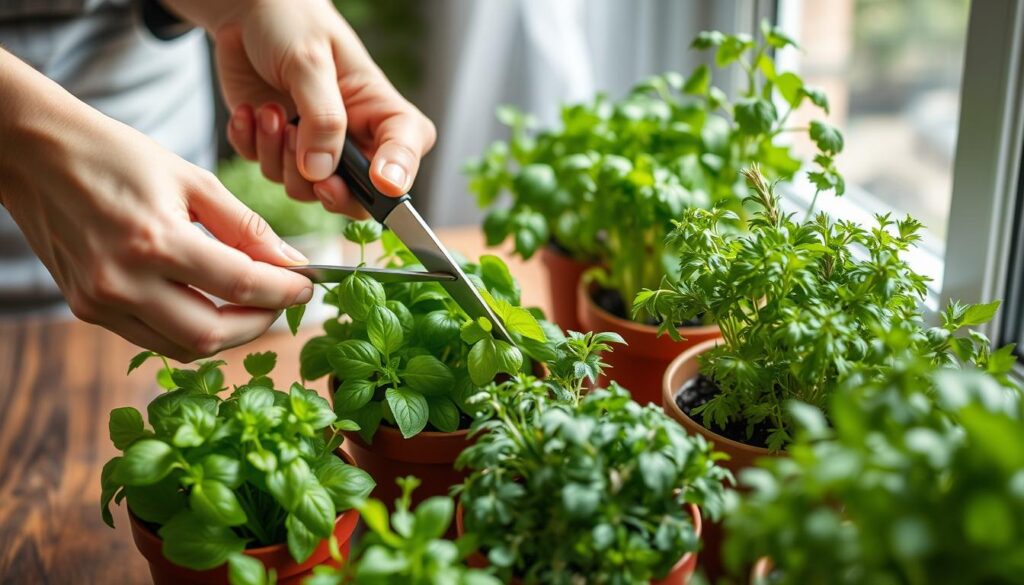
“Proper harvesting and pruning techniques are the keys to a productive and long-lasting indoor herb garden.”
Indoor Herb Garden Maintenance
Looking after your indoor herb garden means you need to keep an eye on it. This includes moving plants into bigger pots and splitting them when they get too crowded. This helps your herbs grow strong and healthy.
Repotting Indoor Herbs
Repotting is key in indoor herb garden care. You’ll know it’s time when the roots start poking out of the holes or the soil dries out fast. Pick a pot that’s a bit bigger, and fill it with good quality potting mix made for herbs.
Take the plant out of its old pot carefully. Loosen the roots before putting it in the new pot. Make sure not to hurt the roots.
Dividing Indoor Herbs
Dividing your herbs is another important step. Plants like mint, oregano, and chives can get too close together, slowing down their growth. To split them, take the whole root ball out of the pot.
Then, use a sharp tool to cut the roots and separate the plants. Make sure each piece has its roots. Put each part in its own pot, water well, and watch them flourish.
By keeping up with repotting indoor herbs and dividing them, your garden will keep giving you fresh, tasty herbs for your cooking.
Troubleshooting Common Issues
Keeping an indoor herb garden can be rewarding, but it’s not always easy. Even experienced gardeners face challenges like leggy plants, yellow leaves, and pests. Knowing how to fix these problems is crucial for a healthy, lively garden.
Leggy or stunted growth is a common issue. It usually means your herbs don’t get enough light or are too crowded. Make sure they get at least 6 hours of sunlight a day. If sunlight is limited, use a grow light. Also, don’t pack your containers too tightly to give your herbs enough room to grow.
Yellowing leaves can mean you’re watering too much, too little, or your plants lack nutrients. Check how often you water and let the soil dry out a bit between waterings. If leaves keep turning yellow, test the soil pH and change your fertilizer if needed.
- Troubleshoot leggy or stunted growth by providing more light and spacing plants appropriately.
- Address yellowing leaves by adjusting your watering and fertilizing practices.
- Identify and manage pests proactively to maintain a healthy indoor herb garden.
Pests like aphids, spider mites, and whiteflies can trouble indoor herb gardens. Keep an eye on your plants and deal with infestations fast. Using natural pest control, like beneficial insects or insecticidal soaps, can help.
“With a little troubleshooting and proactive care, your indoor herb garden can thrive year-round, providing you with a bountiful supply of fresh, flavorful ingredients.”
Pay attention to your indoor herbs and fix problems quickly to keep your garden thriving. With the right care, your homegrown herbs will always add flavor and aroma to your cooking.
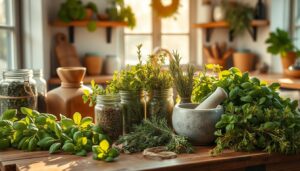
Creative Uses for Your Homegrown Herbs
Growing your own herbs at home offers more than just fresh ingredients. It opens up new ways to use their unique flavors and smells. You can cook with indoor herbs, make tasty herb infusions, and enjoy herb teas. The options are endless when you use indoor herbs in your everyday life.
Cooking with Fresh Herbs
Having a thriving indoor herb garden means you always have fresh herbs for cooking. These herbs can make even simple dishes taste amazing. Just add fresh basil, thyme, or rosemary to roasted veggies, pasta, or grilled meats for a flavor boost.
Herbal Teas and Infusions
Your indoor herbs can also help you relax and stay healthy. Make calming herb teas with mint, lemon balm, or chamomile. Or try herb infusions by mixing herbs with vodka, gin, or honey. These drinks can be enjoyed alone or added to cocktails for a special touch.
| Herb | Culinary Uses | Wellness Benefits |
|---|---|---|
| Basil | Pesto, pasta, tomato dishes | Anti-inflammatory, antioxidant |
| Mint | Teas, cocktails, salads | Digestive aid, mood-boosting |
| Rosemary | Roasted meats, potatoes, breads | Improves memory, anti-stress |
Let your creativity flow with your homegrown herbs. Whether you’re cooking with indoor herbs, making herb teas, or creating herb infusions, your garden is a source of endless inspiration.
“Herbs are the friends of the physician and the pride of cooks.” – Charlemagne
Conclusion
Starting an indoor herb garden is both rewarding and practical. It gives you fresh, flavorful herbs all year. This guide shows you how to grow a thriving garden. You’ll learn about choosing the right herbs and how to care for them.
With patience and care, you can enjoy a garden full of herbs. This is great for improving your cooking skills or just enjoying the beauty of nature indoors. You’ll have a steady supply of fresh herbs.
Having an indoor herb garden brings many benefits. You get fresh, flavorful ingredients and a constant supply of herbs. This guide has given you the tools to start and keep your garden healthy.
By using a small space for your garden, you open up a world of flavors and aromas. Enjoy the process and try different herbs. With the right care, your garden will flourish, adding freshness to your daily life.
FAQ
What is the benefit of starting an indoor herb garden from seeds?
What are some of the easiest herbs to grow indoors?
How much light do indoor herbs require?
How often should I water my indoor herb garden?
What are some common pests that can affect indoor herbs?
How do I harvest and prune my indoor herbs?
Do I need to repot my indoor herbs as they grow?
Source Links
- How To Grow Herbs From Seed Successfully Every Time – https://www.geturbanleaf.com/blogs/care/how-to-grow-herbs-from-seeds?srsltid=AfmBOoqkJDl09CbOAg2e9NgJipo-FraqzPfo49oVnqjsuql3af64jTkS
- How to Start an Indoor Herb Garden from Seeds – https://shiftingroots.com/indoor-herb-garden/
- How to Start an Herb Garden Indoors • Gardenary – https://www.gardenary.com/blog/how-to-start-an-herb-garden-indoors


